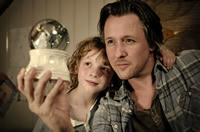“Every subject can have its place in a Dutch youth film”
 When it comes to children’s film, The Netherlands are European market leaders, in quality and probably in quantity. At Cinekid, Amsterdam, MIFFY (by Hans Perk) was awarded ‘Best Dutch Children’s Film 2013’ while the audience chose for anti-bully film REGRET! by Dave Schram. And now FINN and A CHRISTMOOSE STORY are competing in Berlinale’s Generation.
When it comes to children’s film, The Netherlands are European market leaders, in quality and probably in quantity. At Cinekid, Amsterdam, MIFFY (by Hans Perk) was awarded ‘Best Dutch Children’s Film 2013’ while the audience chose for anti-bully film REGRET! by Dave Schram. And now FINN and A CHRISTMOOSE STORY are competing in Berlinale’s Generation.
Can Monique Ruinen reveal the secret of this success? Formerly working as dramaturge and assistant director, trained in the Cinekid festival and at a broadcasting company, now her time has come to combine all this expertise as a consultant for youth & family film at the Dutch Film Fund. Is there a magic potion in the Dutch tap water that turns every children’s film project into gold?
Monique Ruinen: “Every year the Dutch Film Fund has consultants advising and evaluating each project presented. There are consultants for talent development, cinematic experiment, mainstream / crossover cinema, arthouse, documentary and animation, as well as for children and youth film. I advise the administrators about every children’s film application. With 83 children’s films in 10 years, I dare to say the Film Fund fulfils its mission in striving for an “Outstanding & Diverse” film landscape.”
 Can your choices determine the future direction of Dutch children’s film industry?
Can your choices determine the future direction of Dutch children’s film industry?
Ruinen: “For the Fund it is important to continue offering a wide range of films, from toddlers to teenagers, original stories, artistic productions and family films. All this can’t be accomplished at once, but it is my goal within my 3-year mandate. At a European level I’m convinced we can find new opportunities in development and co-production.”
Is there an expiry date for the success of Dutch children’s film?
Ruinen: “This year there have been cutbacks in the Fund’s budget. In a few years this might show in the number of productions, which could possibly cost us our top position. On the other hand the government decided about special measures in aid of production, to overcome a gap with other nations. It is so important that children learn about their culture and complement that knowledge with other flavours and different ways of storytelling. This is a priority. Moreover the youth and family film has grown mature over the last 15 years, with yet a strong economic impact: children’s films make up 23% of Dutch production, but represent 48% of the tickets sold for Dutch films. This implemented a new way of thinking.”
Now it’s going to happen… Finally you may reveal us the secret behind the success of Dutch children’s cinema!
Ruinen: “I’m afraid there is no secret, only a combination of several factors, including:
- Investing in development.
- A tradition in children’s television, developed by trial and error.
- Splendid children’s authors, with Annie M.G. Schmidt as most famous specimen.
- The commitment of Dutch producers, with Burny Bos (Bos Bros) and Leontine Petit (Lemming) as pioneers.
- Support from the Film Fund and the broadcasters.
The ground breaking success of THE FLYING LIFTBOY (Ben Sombogaart, 1998) marked the start of a series of successful book adaptations, such as MINOES and LITTLE CRUMB. And the development project Cinema Junior supported the production of six films based on original material, with a bit more artistic appeal than the usual family film. That’s where KAUWBOY, BONKERS and FIDGETY BRAM were born.”
 What is your opinion about the recent crop, let’s call it ‘the post-KAUWBOY era’?
What is your opinion about the recent crop, let’s call it ‘the post-KAUWBOY era’?
Ruinen: Those films originate from before my time as a consultant. CLASS OF FUN 2, FINN and A CHRISTMOOSE STORY were three Christmas releases. LIFE ACCORDING TO NINO by Simone van Dusseldorp (FROGS AND TOADS, SECRET LETTER) makes an extraordinary impression. But several more interesting files are waiting on my desk.”
One of those might be BOY 7, a science fiction film by Lourens Blok (STAY!).
Ruinen: “I’d be happy to include projects for ‘young adults’. Children’s literature made it happen for children’s film, now I’m hoping the same for teen movies. And there are people like Frans Weisz, 75 year old veteran of Dutch cinema, who just made his first children’s film. For FINN he had to adapt a totally new way of thinking and working. Isn’t that admirable?”
Even the duo Maria Peters (GREETINGS FROM MIKE! about a boy’s fight against cancer) and Dave Schram (REGRET!) again both made a relevant movie.
Ruinen: “Both directors have been so important for the development of our industry. Youth filmmaking is about everything they do, and they put their heart and soul into it. Both films deal with delicate issues. But every subject can have its place in a Dutch youth film, on the condition that we give the young audience something to hang on to. When it comes to children’s film, this has become one of our best qualities.”
Is there also a new generation of producers following in these footsteps?
Ruinen: Definitely! Bijker Film and Rinkel Film (COOL KIDS DON’T CRY) is a strong combination with more than only SECRETS OF WAR in the making. Viking Film is working on its first project for children and Caviar Film is an interesting new player. Those people learned the job in big production companies and now carry out the love for children’s film into their own business.”
Some might remember you from your times at Cinekid. How do you look back upon those festival years?
Ruinen: “As a great time with a great festival! Cinekid and I are carrying out the same passion. I’m immensely happy to come back to the festival now in my new position.”
Meanwhile how are Dutch films doing on the international platform?
Ruinen: “An international children’s film release isn’t easy. Every now and then a Dutch title is released in Belgium, Scandinavia or Germany, usually in a dubbed version. Whoever wants to internationally distribute a Dutch movie, can apply for financial dubbing support.”
Do you have an ultimate dream project that you ever want to see for real?
Ruinen: “Not really. You know… children’s film is not a genre. It’s a type of film for a specific audience in which every genre can be used. The possibilities are limitless.”
Gert Hermans
